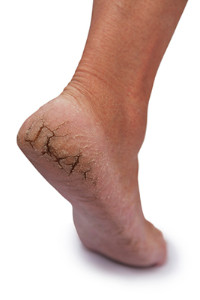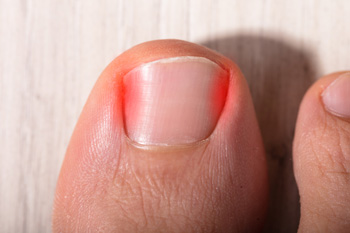Connect With Us
Blog
Items filtered by date: August 2019
Is Plantar Fasciitis Painful?
 The most noticeable symptoms of the medical condition that is known as plantar fasciitis are heel pain and severe discomfort. The plantar fascia is located on the bottom of the foot, and it connects the heel to the toes. If this becomes injured, it may become inflamed, and plantar fasciitis may develop. This condition can be caused by high arches, an injury that has happened to the foot, or participating in certain sporting activities. Relief can be felt when orthotics are worn, and this may be beneficial in reducing existing strain to the plantar fascia. Some patients find it helpful to perform frequent stretching techniques, and this may also aid in strengthening the affected areas of the foot. If you have heel pain, please consult with a podiatrist who can begin the correct treatment options for you.
The most noticeable symptoms of the medical condition that is known as plantar fasciitis are heel pain and severe discomfort. The plantar fascia is located on the bottom of the foot, and it connects the heel to the toes. If this becomes injured, it may become inflamed, and plantar fasciitis may develop. This condition can be caused by high arches, an injury that has happened to the foot, or participating in certain sporting activities. Relief can be felt when orthotics are worn, and this may be beneficial in reducing existing strain to the plantar fascia. Some patients find it helpful to perform frequent stretching techniques, and this may also aid in strengthening the affected areas of the foot. If you have heel pain, please consult with a podiatrist who can begin the correct treatment options for you.
Plantar fasciitis can be very painful and inconvenient. If you are experiencing heel pain or symptoms of plantar fasciitis, contact Scott Matthews, DPM, MD from Salem Foot Care . Our doctor can provide the care you need to keep you pain-free and on your feet.
What Is Plantar Fasciitis?
Plantar fasciitis is the inflammation of the thick band of tissue that runs along the bottom of your foot, known as the plantar fascia, and causes mild to severe heel pain.
What Causes Plantar Fasciitis?
- Excessive running
- Non-supportive shoes
- Overpronation
- Repeated stretching and tearing of the plantar fascia
How Can It Be Treated?
- Conservative measures – anti-inflammatories, ice packs, stretching exercises, physical therapy, orthotic devices
- Shockwave therapy – sound waves are sent to the affected area to facilitate healing and are usually used for chronic cases of plantar fasciitis
- Surgery – usually only used as a last resort when all else fails. The plantar fascia can be surgically detached from the heel
While very treatable, plantar fasciitis is definitely not something that should be ignored. Especially in severe cases, speaking to your doctor right away is highly recommended to avoid complications and severe heel pain. Your podiatrist can work with you to provide the appropriate treatment options tailored to your condition.
If you have any questions please feel free to contact our office located in Wikesboro, NC . We offer the newest diagnostic and treatment technologies for all your foot and ankle needs.
Toddlers and Walking Barefoot
 There are several bones, joints, and ligaments that the human foot is comprised of. When babies are born, their feet are flexible, and will gradually become stronger as walking begins. Babies are typically born with flat feet, and the arch generally develops as the feet become stronger. Research has indicated that it is beneficial for toddlers to walk barefoot while indoors, and this can help the toes to strengthen by grasping the floor. When the first pair of shoes are purchased, the feet should be properly measured, and this is helpful in determining the correct shoe size. It is important that the shoes have flat and flexible soles, in addition to ensuring that there is inadequate room for the toes to move freely in. If you would like more information about how to care for your child’s feet, please consult with a podiatrist.
There are several bones, joints, and ligaments that the human foot is comprised of. When babies are born, their feet are flexible, and will gradually become stronger as walking begins. Babies are typically born with flat feet, and the arch generally develops as the feet become stronger. Research has indicated that it is beneficial for toddlers to walk barefoot while indoors, and this can help the toes to strengthen by grasping the floor. When the first pair of shoes are purchased, the feet should be properly measured, and this is helpful in determining the correct shoe size. It is important that the shoes have flat and flexible soles, in addition to ensuring that there is inadequate room for the toes to move freely in. If you would like more information about how to care for your child’s feet, please consult with a podiatrist.
Making sure that your children maintain good foot health is very important as they grow. If you have any questions, contact Scott Matthews, DPM, MD of Salem Foot Care . Our doctor can provide the care you need to keep you pain-free and on your feet.
Keeping Children's Feet Healthy
Having healthy feet during childhood can help prevent medical problems later in life, namely in the back and legs. As children grow, their feet require different types of care. Here are some things to consider...
Although babies do not walk yet, it is still very important to take care of their feet.
Avoid putting tight shoes or socks on his or her feet.
Allow the baby to stretch and kick his or her feet to feel comfortable.
As a toddler, kids are now on the move and begin to develop differently. At this age, toddlers are getting a feel for walking, so don’t be alarmed if your toddler is unsteady or ‘walks funny’.
As your child gets older, it is important to teach them how to take care of their feet.
Show them proper hygiene to prevent infections such as fungus.
Be watchful for any pain or injury.
Have all injuries checked by a doctor as soon as possible.
Comfortable, protective shoes should always be worn, especially at play.
If you have any questions please feel free to contact our office located in Wikesboro, NC . We offer the newest diagnostic and treatment technologies for all your foot and ankle needs.
What Causes Gout?
 Elevated uric acid levels in the bloodstream may lead to a painful condition that is known as gout. It typically affects the joints in the big toe, and symptoms generally consist of swelling, redness, and severe pain and discomfort. It can occur as a result of crystals that form and lodge in the joints, which is caused by eating foods that have high purine levels. These foods can include red meat, shellfish, and excess amounts of alcohol. After a proper diagnosis is performed, which can consist of extracting fluid from the affected joint that contains the crystals, proper treatment can begin. This can include taking medication which can lower uric acid levels. There are methods that can be implemented which may prevent gout attacks from occurring. It is beneficial to incorporate healthy eating habits into your daily routine, and limiting the amount of alcohol that is consumed. If you have frequent gout attacks, it is suggested that you consult with a podiatrist who can treat this condition.
Elevated uric acid levels in the bloodstream may lead to a painful condition that is known as gout. It typically affects the joints in the big toe, and symptoms generally consist of swelling, redness, and severe pain and discomfort. It can occur as a result of crystals that form and lodge in the joints, which is caused by eating foods that have high purine levels. These foods can include red meat, shellfish, and excess amounts of alcohol. After a proper diagnosis is performed, which can consist of extracting fluid from the affected joint that contains the crystals, proper treatment can begin. This can include taking medication which can lower uric acid levels. There are methods that can be implemented which may prevent gout attacks from occurring. It is beneficial to incorporate healthy eating habits into your daily routine, and limiting the amount of alcohol that is consumed. If you have frequent gout attacks, it is suggested that you consult with a podiatrist who can treat this condition.
Gout is a foot condition that requires certain treatment and care. If you are seeking treatment, contact Scott Matthews, DPM, MD from Salem Foot Care . Our doctor will treat your foot and ankle needs.
What Is Gout?
Gout is a type of arthritis caused by a buildup of uric acid in the bloodstream. It often develops in the foot, especially the big toe area, although it can manifest in other parts of the body as well. Gout can make walking and standing very painful and is especially common in diabetics and the obese.
People typically get gout because of a poor diet. Genetic predisposition is also a factor. The children of parents who have had gout frequently have a chance of developing it themselves.
Gout can easily be identified by redness and inflammation of the big toe and the surrounding areas of the foot. Other symptoms include extreme fatigue, joint pain, and running high fevers. Sometimes corticosteroid drugs can be prescribed to treat gout, but the best way to combat this disease is to get more exercise and eat a better diet.
If you have any questions please feel free to contact our office located in Wikesboro, NC . We offer the newest diagnostic and treatment technologies for all your foot and ankle needs.
Possible Causes Of Cracked Heels
 Cracked heels are a common foot condition, especially during the summer months. This can be a result of wearing shoes that have an open back, which typically provides inadequate support for the heel of the foot. The skin can become dry, and deep cracks that are known as fissures may form. Additional reasons why this condition may develop can include standing for extended periods of time throughout the day, excess weight the heels endure from being obese, and walking with a specific gait. Mild relief can be found when the feet are soaked in warm water, followed by using a good moisturizer frequently during the day. Research has indicated the importance of wearing shoes that fit properly, as this can be helpful in preventing cracked heels. If you are suffering from this ailment, it is suggested to consult with a podiatrist who can guide you toward the correct treatment.
Cracked heels are a common foot condition, especially during the summer months. This can be a result of wearing shoes that have an open back, which typically provides inadequate support for the heel of the foot. The skin can become dry, and deep cracks that are known as fissures may form. Additional reasons why this condition may develop can include standing for extended periods of time throughout the day, excess weight the heels endure from being obese, and walking with a specific gait. Mild relief can be found when the feet are soaked in warm water, followed by using a good moisturizer frequently during the day. Research has indicated the importance of wearing shoes that fit properly, as this can be helpful in preventing cracked heels. If you are suffering from this ailment, it is suggested to consult with a podiatrist who can guide you toward the correct treatment.
If the skin on your feet starts to crack, you may want to see a podiatrist to find treatment. If you have any concerns, contact Scott Matthews, DPM, MD from Salem Foot Care . Our doctor can provide the care you need to keep you pain-free and on your feet.
Cracked Heels
It is important to moisturize your cracked heels in order to prevent pain, bleeding, and infection. The reason cracked heels form is because the skin on the foot is too dry to support the immense pressure placed on them. When the foot expands, the dry skin on the foot begins to split.
Ways to Help Heal Them
- Invest in a good foot cream
- Try Using Petroleum Jelly
- Ease up on Soaps
- Drink Plenty of Water
Ways to Prevent Cracked Heels
- Moisturize After Showering
- Skip a Shower
- Keep Shower Water Lukewarm
- Don’t Scrub Your Feet
If you are unsure how to proceed in treating cracked heels, seek guidance from a podiatrist. Your doctor will help you with any questions or information you may need.
If you have any questions, please feel free to contact our office located in Wikesboro, NC . We offer the newest diagnostic and treatment technologies for all your foot care needs.
Ingrown Toenails Can Cause Pain
The symptoms of an ingrown toenail can be quite noticeable. They typically consist of red and swollen skin on the sides of the big toe, and it generally causes pain and discomfort. It can occur as a result of wearing shoes that do not fit properly, and this can possibly cause the toenail to grow into the surrounding skin. If your child has an ingrown toenail, they may find mild relief when the affected toe is soaked in warm water. This may help to move the swollen portion of skin away from the nail. It may be beneficial to wear sandals as the healing process occurs, and this can help to keep pressure off of the nail. If you are afflicted with an ingrown toenail, it is strongly advised that you seek the counsel of a podiatrist who can properly treat this condition.
Ingrown toenails can become painful if they are not treated properly. For more information about ingrown toenails, contact Scott Matthews, DPM, MD of Salem Foot Care . Our doctor can provide the care you need to keep you pain-free and on your feet.
Ingrown Toenails
Ingrown toenails occur when a toenail grows sideways into the bed of the nail, causing pain, swelling, and possibly infection.
Causes
- Bacterial infections
- Improper nail cutting such as cutting it too short or not straight across
- Trauma to the toe, such as stubbing, which causes the nail to grow back irregularly
- Ill-fitting shoes that bunch the toes too close together
- Genetic predisposition
Prevention
Because ingrown toenails are not something found outside of shoe-wearing cultures, going barefoot as often as possible will decrease the likeliness of developing ingrown toenails. Wearing proper fitting shoes and using proper cutting techniques will also help decrease your risk of developing ingrown toenails.
Treatment
Ingrown toenails are a very treatable foot condition. In minor cases, soaking the affected area in salt or antibacterial soaps will not only help with the ingrown nail itself, but also help prevent any infections from occurring. In more severe cases, surgery is an option. In either case, speaking to your podiatrist about this condition will help you get a better understanding of specific treatment options that are right for you.
If you have any questions please feel free to contact our office located in Wikesboro, NC . We offer the newest diagnostic and treatment technologies for all your foot and ankle needs.
Blog Archives
- March 2025
- February 2025
- January 2025
- December 2024
- November 2024
- October 2024
- September 2024
- August 2024
- July 2024
- June 2024
- May 2024
- April 2024
- March 2024
- February 2024
- January 2024
- December 2023
- November 2023
- October 2023
- September 2023
- August 2023
- July 2023
- June 2023
- May 2023
- April 2023
- March 2023
- February 2023
- January 2023
- December 2022
- November 2022
- October 2022
- September 2022
- August 2022
- July 2022
- June 2022
- May 2022
- April 2022
- March 2022
- February 2022
- January 2022
- December 2021
- November 2021
- October 2021
- September 2021
- August 2021
- July 2021
- June 2021
- May 2021
- April 2021
- March 2021
- February 2021
- January 2021
- December 2020
- November 2020
- October 2020
- September 2020
- August 2020
- July 2020
- June 2020
- May 2020
- April 2020
- March 2020
- February 2020
- January 2020
- December 2019
- November 2019
- October 2019
- September 2019
- August 2019
- July 2019
- June 2019
- May 2019
- April 2019
- March 2019
- February 2019
- January 2019
- December 2018
- November 2018
- October 2018
- September 2018
- August 2018
- July 2018
- June 2018
- May 2018


